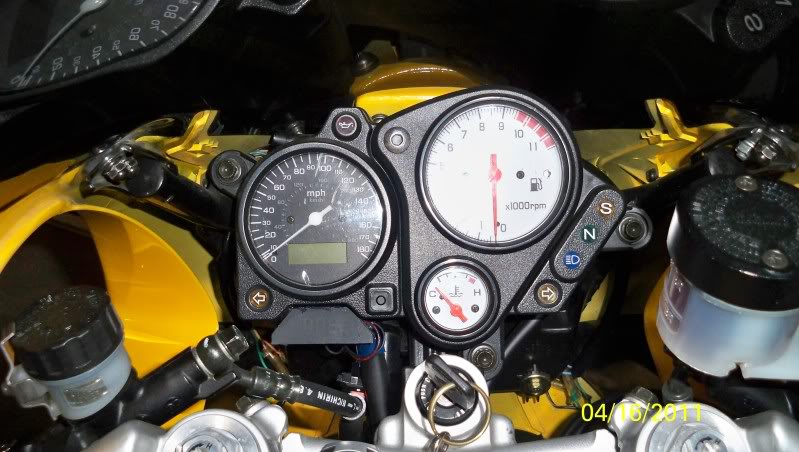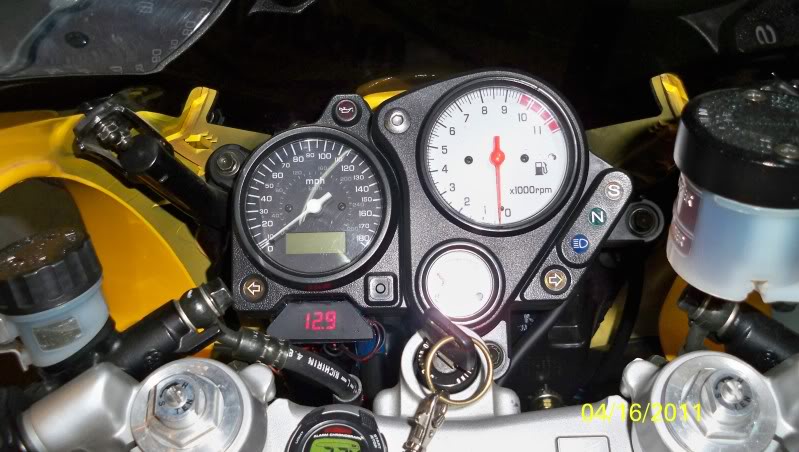Digital Voltage Regulator Adaptation
#1
Digital Voltage Regulator Adaptation
After doing much searching for a voltage indicator for my Hawk and only coming up with lights that flash or come on when there is a problem (which is much better than nothing) and being a hot rod guy I prefer to see exactly what it is doing so I went about modifying a digital gauge for it. This is what I came up with. I might still change what I have it mounted in but for now it works.




#5
Probably the most difficult part is finding a good unit to use. Try this one:
BikeMeters.com - Digital Voltmeters manufactured by DATEL
#6
Power and ground, not that difficult......
Probably the most difficult part is finding a good unit to use. Try this one:
BikeMeters.com - Digital Voltmeters manufactured by DATEL
Probably the most difficult part is finding a good unit to use. Try this one:
BikeMeters.com - Digital Voltmeters manufactured by DATEL
EDIT: wow $50 for that? jeez i aint made of money
Last edited by nykuryu; 04-16-2011 at 10:05 PM.
#7
If you don't need water resistant, I am using this one currently.
I used quick connects so I could remove it when I wash the bike.

STINGER SVMR VOLTMETER RED 3-DIGIT DIGITAL DISPLAY NEW | eBay
I used quick connects so I could remove it when I wash the bike.

STINGER SVMR VOLTMETER RED 3-DIGIT DIGITAL DISPLAY NEW | eBay
#10
Mini Red LED Volt Meter DC 6-15V Doesn't Require Power | eBay
this one is pretty tiny. i have to question the quality of all these meters tho
this one is pretty tiny. i have to question the quality of all these meters tho
#11
Wow, that's not bad at all.
I agree with the quality concern, but for under $10 for the one you posted, how can you really go wrong?
But it really isn't that much smaller.
I agree with the quality concern, but for under $10 for the one you posted, how can you really go wrong?
But it really isn't that much smaller.
Last edited by superh1998; 04-16-2011 at 11:39 PM.
#15
#17
Why do you want to hook up a digital voltmeter to the bike? It does several things, only one of them any good...
One... It drains the battery while the bike is sitting... There is no way possible to build a voltmeter that doesn't... Laws of physics apply, and they say it will drain... You could hook it up through a switch, that solves that problem...
Two... It needs a fuse if you hook it up directly. If you hook it up somewhere else, it's fused through the fuse for that part of the bike... Running it without a fuse is a very, very bad idea, it could mean that a small failure like a worn through wire insulation leaves you stranded to get a tow home with expensive repairs afterwards...
Three... A cheap digital voltmeter like that isn't really accurate enough to display the voltage spikes that can occur with a failing R/R...
If the voltage spikes to 16 something volts fort a very short time, that display will show you 15 something going up, and 15 something coming down from the peak... No way will it be fast enough to actually show you, or for you to read 16 something on the display... A LCD display is even slower than the red LED display is, so the more complex and expensive, the worse results...
It's a very good indication though... But don't trust it completely...
This https://www.superhawkforum.com/forum...dicator-11410/, is a simpler, more robust way... Less cost, more accuracy... If there is a LED lit or flickering, ride straight home and investigate the cause... It tells you if the voltage is higher than desired, or lower... Then a handheld multimeter will tell you more, and with more accuracy than any $50+ onboard meter can...
BTW, if you want to buy a smaller, more sleek looking one, I can sell you one... But it's just the same as the one you can build for change yourself...
One... It drains the battery while the bike is sitting... There is no way possible to build a voltmeter that doesn't... Laws of physics apply, and they say it will drain... You could hook it up through a switch, that solves that problem...
Two... It needs a fuse if you hook it up directly. If you hook it up somewhere else, it's fused through the fuse for that part of the bike... Running it without a fuse is a very, very bad idea, it could mean that a small failure like a worn through wire insulation leaves you stranded to get a tow home with expensive repairs afterwards...
Three... A cheap digital voltmeter like that isn't really accurate enough to display the voltage spikes that can occur with a failing R/R...
If the voltage spikes to 16 something volts fort a very short time, that display will show you 15 something going up, and 15 something coming down from the peak... No way will it be fast enough to actually show you, or for you to read 16 something on the display... A LCD display is even slower than the red LED display is, so the more complex and expensive, the worse results...
It's a very good indication though... But don't trust it completely...
This https://www.superhawkforum.com/forum...dicator-11410/, is a simpler, more robust way... Less cost, more accuracy... If there is a LED lit or flickering, ride straight home and investigate the cause... It tells you if the voltage is higher than desired, or lower... Then a handheld multimeter will tell you more, and with more accuracy than any $50+ onboard meter can...
BTW, if you want to buy a smaller, more sleek looking one, I can sell you one... But it's just the same as the one you can build for change yourself...
#18
XSCORPION DVM3R Red Digital Amp Voltage Meter Amplifier | eBay
This is the item I bought for 14 dollars. Took it apart and took out the gauge and installed it in a case I built out of plexiglass and silicone. Then painted it with some flat black paint, just lightly on the front so that it would black out the case and dim the red light some for night driving, it was rather bright.
I ran it directly to the battery through a switch and a fuse so it is not going to damage anything else if it fries.
Granted that if it gives a spiked reading momentarily I would probably never see it but I like to see that it is operating well. I can get my battery voltage reading while it is sitting which will help me diagnose a bad battery when the time comes by noticing drops in voltage after it has sat or see how fast it drops when I turn the key on. All without having to get my handheld multimeter out, removing the seat and checking it.
It was giving me about a 12.4 on the battery when I first hooked it up. While running at idle or about 2000 rpm I was getting between 13.8 to 14.2 although it was not a steady reading as the 10th reading would constantly fluctuate but stayed just about 14.so I know exactly how much the regulator is putting out. Which was a big concern for me after doing my R/R swap. Just for my own peice of mind.
I was totally ready to build you charge indicator Tweety, I still might but I thought I would like this as it seemed to have many advantages for me and it was only 14 dollars so if it worked out for me AWESOME if not I would build yours and only be out $14 so no big loss.
This is the item I bought for 14 dollars. Took it apart and took out the gauge and installed it in a case I built out of plexiglass and silicone. Then painted it with some flat black paint, just lightly on the front so that it would black out the case and dim the red light some for night driving, it was rather bright.
I ran it directly to the battery through a switch and a fuse so it is not going to damage anything else if it fries.
Granted that if it gives a spiked reading momentarily I would probably never see it but I like to see that it is operating well. I can get my battery voltage reading while it is sitting which will help me diagnose a bad battery when the time comes by noticing drops in voltage after it has sat or see how fast it drops when I turn the key on. All without having to get my handheld multimeter out, removing the seat and checking it.
It was giving me about a 12.4 on the battery when I first hooked it up. While running at idle or about 2000 rpm I was getting between 13.8 to 14.2 although it was not a steady reading as the 10th reading would constantly fluctuate but stayed just about 14.so I know exactly how much the regulator is putting out. Which was a big concern for me after doing my R/R swap. Just for my own peice of mind.
I was totally ready to build you charge indicator Tweety, I still might but I thought I would like this as it seemed to have many advantages for me and it was only 14 dollars so if it worked out for me AWESOME if not I would build yours and only be out $14 so no big loss.
#20
Well... With a fuse and switch in there, it most certainly does what you ask of it...  So that's good... I just felt it was a good thing that people knew the limitations... The expensive one in gord's post is a prime example of looking good and costing a lot of money, for something that's a really, really bad implemention... It will not reliably do what they say it's supposed too... It simply can't...
So that's good... I just felt it was a good thing that people knew the limitations... The expensive one in gord's post is a prime example of looking good and costing a lot of money, for something that's a really, really bad implemention... It will not reliably do what they say it's supposed too... It simply can't...
Thread
Thread Starter
Forum
Replies
Last Post











